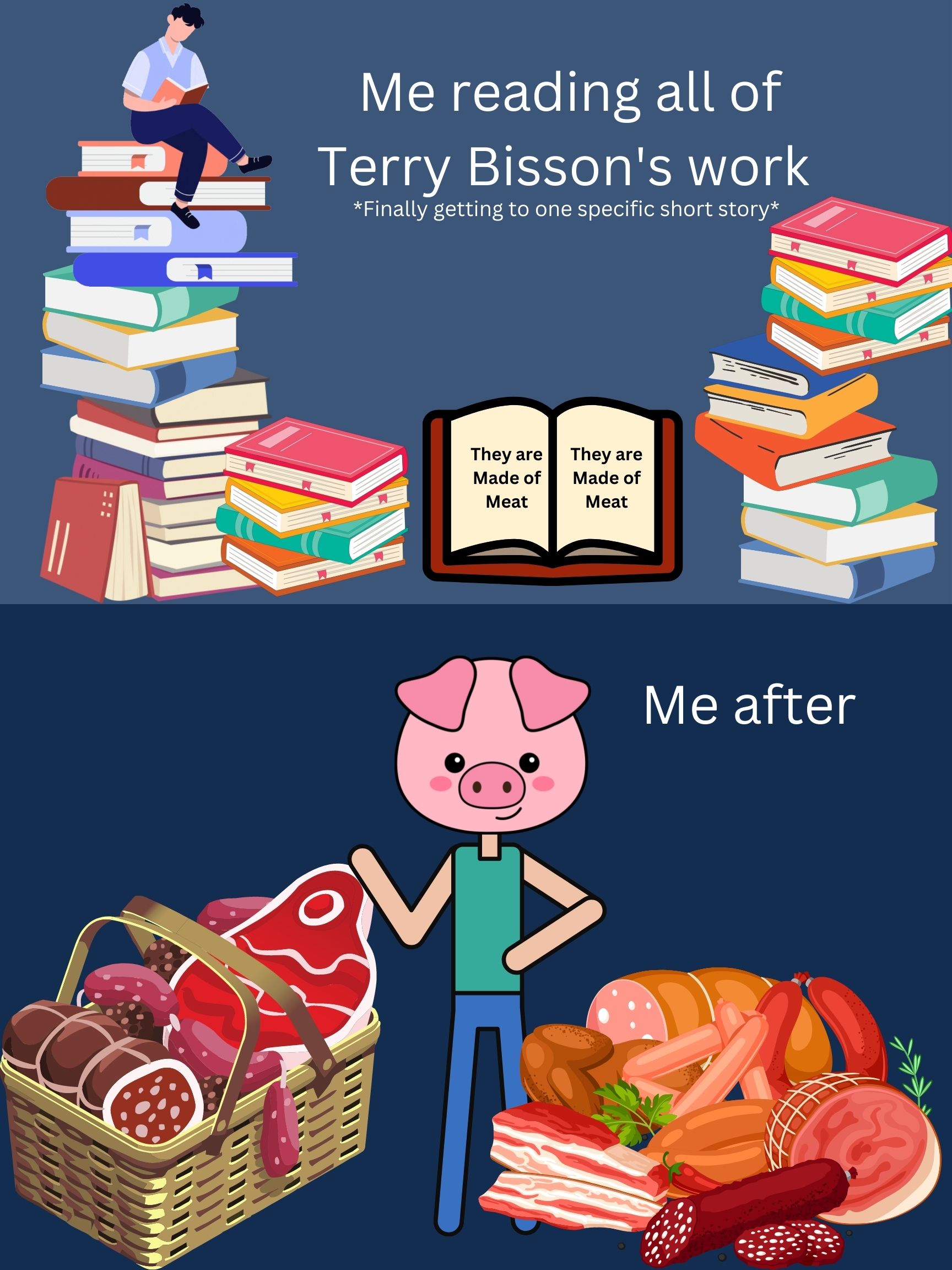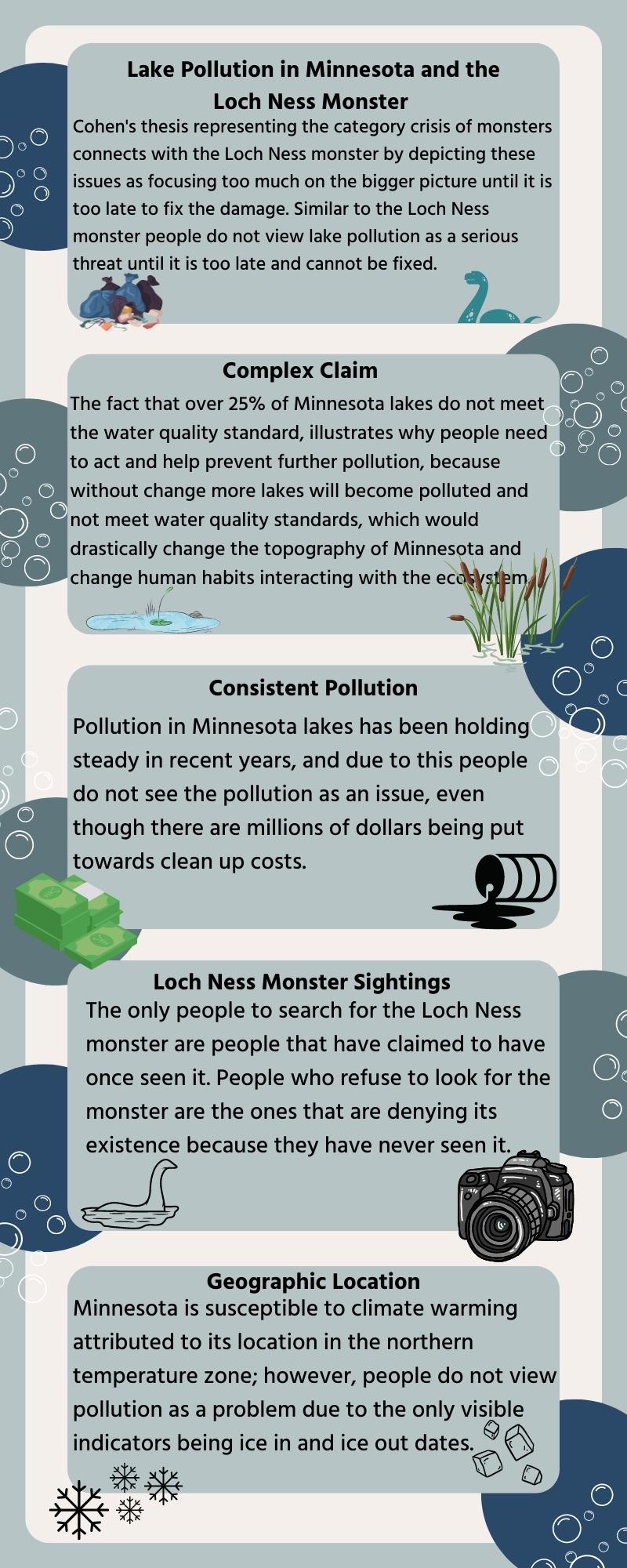8 Minnesota Lake Pollution and The Loch Ness Monster
dlohrenz
Introduction
Chemical runoff is polluting lakes in Minnesota, and the effects are becoming permanent. In 2014, a mere nine of the twenty bays in Lake Minnetonka met the NCHF ecoregion eutrophication standards. Unfortunately, this number has decreased over the years as eutrophication has continuously worsened (Osgood, 2013). Cohen’s thesis representing the category crisis of monsters connects with the Loch Ness Monster because people deem the Loch Ness Monster as a scary figure that is not only elusive to the eye but is also a monster that cannot be defeated. Humans only worry about this Monster once it is too late to do anything about it. Like the Loch Ness Monster destroying ecosystems and harming humans, people not treating micro pollution and fertilizer runoff in lakes located in Minnesota as a pressing issue with multiple solutions leads to the deterioration of lake ecosystems. Though fertilizer runoff causes exponential growth of algae (which could be seen as a benefit due to the lake ecosystems growing), this is counteractive because the overgrowth of the algae creates an imbalance in the ecosystem.
The fact that over 25% of Minnesota lakes do not meet the water quality standard, illustrates why people need to take action immediately to help prevent further pollution that is drastically changing Minnesota’s topography and human habits surrounding “lake life” (ProQuest).
This paper will explore the fundamental value of having people change their habits to decrease and mitigate further lake pollution in Minnesota before moving into the specific benefits of what will happen to the lakes once a change is made—including but not limited to: thriving ecosystems, increased water quality, less invasive species, and increased water activity.
Solutions
Runoff is causing permanent damage to lakes in Minnesota, harming not only the complex aquatic ecosystems but also putting Minnesota’s economy at risk if the pollution worsens.
Millions of experts have proposed solutions to lessen the impact of chemicals washing into lakes. Dick Osgood, a director of the Lake Minnetonka Association and a local lake advocate, argues that new water regulations, such as the Clean Water Act, are insufficient in protecting the lakes (Osgood, 2013). Instead, laws must be passed addressing agricultural and domestic sources to immediately lessen the implications of runoff. Guido Schnabel, a professor at Clemson University, recommends creating stormwater ponds to prevent harmful chemical runoff from entering more extensive waterways (Schnabel, 2021). Stormwater ponds can keep pollutants from running into larger waterways by collecting in a smaller basin, allowing some chemical pollutants to be filtered out. However, caution is vital with this solution as these stormwater ponds are easily corrupted by eutrophication and often require dredging, a tedious and expensive process.
The Minnehaha Creek Watershed District proposed an additional solution to mitigate water pollution. They argue for using tree trenches to capture stormwater runoff to filter the soil (Minnehaha Creek Watershed District 2011). Tree trenches consist of piping for water storage, structural soils, and a tree” (Middle Fork Crow River Watershed District, 2018). In a similar manner to storm ponds, they gather rainwater and then filter the runoff. However, the tree trenches also provide irrigation for the tree while having a much more aesthetically pleasing appearance than the stormwater ponds since stormwater ponds generally accumulate algae. The solution that yields the best results is the Minnehaha Creek Watershed’s. Tree trenches can remove millions of harmful chemicals from the runoff, help contain the runoff, and provide a new habitat for organisms. An additional benefit is they are also aesthetically appealing within modern infrastructure trends.
When discussing the severe implications of lake pollution, a connection may be made when looking into mythological creatures and human behavior.
Most kids are familiar with the tall tales of the Loch Ness Monster and what it does as it lurks deep beneath your feet while you are swimming. Eyes go wide, and mouths hang open as they listen to tales about the giant Loch Ness Monster with an enormous neck that could swallow you whole. As the kids panic, they are soothed with the comforting thought that the monster is not a real threat because no one has seen it in years. A wave of relief washes over the children, and they can sleep at night knowing they will still be able to go swimming as they have been for their whole childhood with no threat… This is similar to how humans view pollution: It’s only a problem when it directly affects them.
People cannot see the direct consequences of their actions and, therefore, continue polluting the lakes.
The connection between the Loch Ness Monster and lake pollution is intertwined. It goes hand in hand with Cohen’s thesis regarding the harbinger of the category crisis because people cannot correctly identify ‘pollution as a monster’ due to its ability to say out of direct eyesight. Cohen touches on the fact that humans are ignorant by nature, and it is not necessarily a choice, but rather humans shielding themselves from the dangers of the unknown.
Resources
“Indicators of Climate Warming in Minnesota: Lake – ProQuest.” Www.proquest.com, www.proquest.com/docview/198560003?pq-origsite=primo&parentSessionId=4qwU3CERmIiAsCjOa%2BBDWnFU8VCmeSDljNpy35WXHlg%3D. Accessed 13 Oct. 2022.
Osgood, D. (2013, February 13). Managing Lake Minnetonka: Clean Water Act. Retrieved from SWNewsMedia.com website: https://www.swnewsmedia.com/lakeshore_weekly/news/opinion/managing-lake-minnetonka-clean-water-act/article_e1851982-eb89-579e-9d99-c2cb8226ae0c.html
Schnabel, G. (2021). Stormwater Pond Design, Construction and Sedimentation | College of Agriculture, Forestry and Life Sciences | Clemson University, South Carolina. Retrieved from www.clemson.edu website: https://www.clemson.edu/extension/water/stormwater-ponds/problem-solving/construct-repair-dredge/index.html
Tree Trenches – Middle Fork Crow River Watershed District. (2018). Retrieved February 4, 2021, from Middle Fork Crow River Watershed District website: https://www.mfcrow.org/new-london-tree-trenches/#:~:text=Tree%20trenches%20manage%20stormwater%20runoff
What is Runoff? (2011, June 22). Retrieved January 13, 2021, from MCWD: Minnehaha Creek Watershed District website: https://www.minnehahacreek.org/education/watershed-basics/what-runoff


